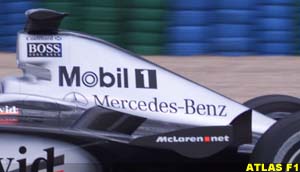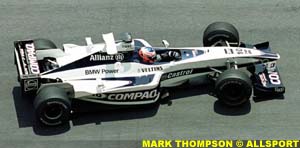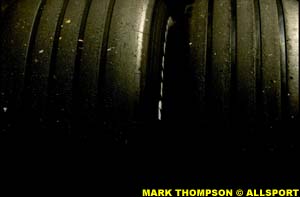| ATLAS F1 Volume 6, Issue 35 | |||
 |
The F1 Rulebook | ||
| by Will Gray, England | |||
|
In a series of articles, Will Gray delves into Formula One's rulebook and investigates the in-depth documentation that governs F1: from rules defining how the event should be run, to those restricting designers and engineers in technical areas
Part Seven: More Defining Dimensions
Although the safety aspects very much define the shape of the main chassis of the car, the FIA also has several defining dimensions which further shape the car for other reasons. In the centre section, even the slope of the engine cover is defined by the FIA. They require bodywork to be present in a specific triangle when the car is viewed from the side, and stipulate that this bodywork must be symmetrical about the centre line, and at least 20cm wide on a line running parallel to and 20cm below the angle defining the engine cover slope. Another triangle defines an area where there must be no bodywork - basically the area above the engine cover and more than 33cm in front of the rear wheels.
Turning to the underside of the car, there are yet more rules which form this into shape. It is an extremely important area of the car because even though its curvature is banned, the flat bottom creates over a third of the car's downforce - so it's an area that the FIA are very keen to restrict. Concerned by ever increasing speeds in Formula One, the FIA introduced the 'step plane' in 1994, and because the car's aerodynamics work best the closer they are to the ground, the downforce was immediately and significantly reduced.
The reference plane (which is basically the plane onto which the 'plank' on the underside of the car is fixed) extends from 33cm rear of the front tyres all the way back to the rear tyres, and must be between 30cm and 50cm wide. This is the closest part of the car to the track, and leads through a radiused edge, to the step plane.
Beneath the reference plane lies the skid block (or 'plank' as it is better know to Grand Prix fans), which must run from the frontmost point of the reference plane (33cm behind the front wheels) to the rear wheels. It is made out of a material with a specific gravity of between 1.3 and 1.45, and must measure 30cm in width, with a tolerance of 0.2cm. Although it decreases in thickness towards the edges to allow a smooth design, the plank most importantly, when measured through six pre-cut 5cm diameter holes, has a tolerance of just one tenth of a centimetre on its 1cm thickness.
The teams suffered problems in the early days of the 'plank' when, with the planks wearing away due to bottoming out on the track when the cars were run at low ride heights, cars were disqualified because the plank dimensions did not fit the rules - the most famous occurrence of which was at the Belgian Grand Prix of 1994, when Michael Schumacher was disqualified. Now however, the teams seem to have this problem under control.
These tyres must contain four 1.4cm wide grooves which are a quarter of a centimetre deep when the tyre begins its life, and they must be symmetrically and evenly spaced about the centre of the tyre tread, with 5cm spacings between each of the centres. However, there are no rules currently regarding the depth of the tyre at the end of its use (although the FIA reserves the right to make one if it so wishes), and so cars run on virtual slicks when the tyre becomes worn - although by this point the compound will have degraded and the tyre will be less grippy anyway!
The systems used by the scrutineers to measure all these dimensions are extremely accurate, so there is no getting away with dimensional inaccuracies nowadays - in fact, teams must be very careful how close to the mark they take it. They will always want to hit the extremities of the rulings, but the consequences of taking it too far are well known, and have been seen many times in recent history. However, because manufacture can sometimes lead to inaccurate part sizing, the FIA have tolerances for the area covered by the reference plane - they will accept a part as legal if it is within half a centimeter either way of the required dimension.
With the number of dimension-defining rules imposed on the teams by the FIA, it is no wonder that many of the cars look like clones - but it is a tribute to the engineering skills of Ferrari and McLaren that they can design cars so far ahead of the rest.
Previous Parts in this Series: Part 1 | Part 2 | Part 3 | Part 4 | Part 5 | Part 6
|
| Will Gray | © 2000 Kaizar.Com, Incorporated. |
| Send comments to: gray@atlasf1.com | Terms & Conditions |


